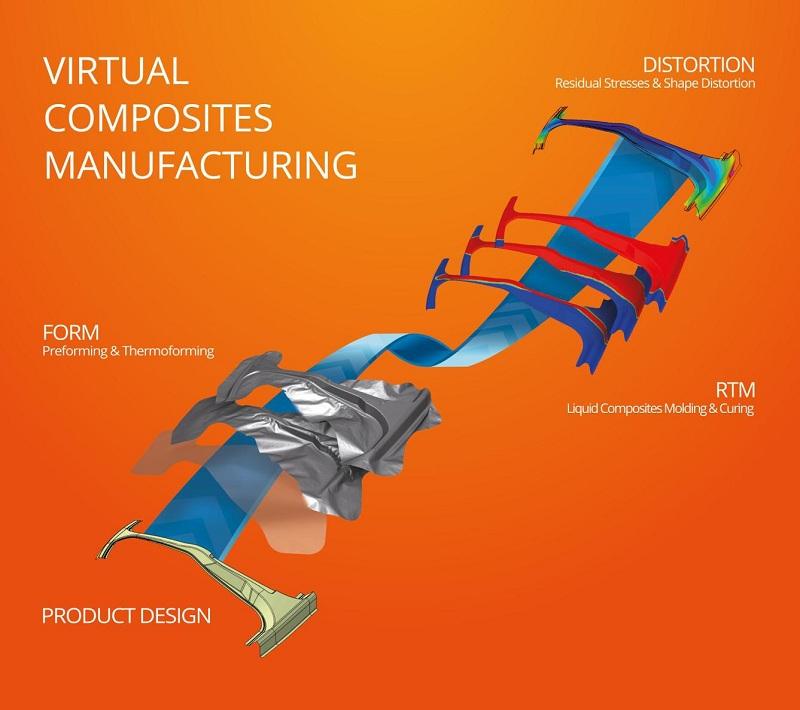ESI presents its Composites Simulation Solution 2015 at JEC Europe
ESI presents its Composites Simulation Solution 2015 at JEC Europe

ESI Group announces the release of ESI’s Composites Simulation Solution 2015. The new solution will be presented at JEC Europe, the world’s largest composites conference and trade show, which takes place in Paris, France from March 10 to 12, 2015.
Amongst the many software solutions available on the market, ESI’s Composites Simulation Solution 2015 is the only Finite Element (FE) simulation solution allowing for the virtual simulation of the complete composites manufacturing chain, starting with simple composite plies and concluding with the final product. The solution represents a key asset for all manufacturers using composite materials, whether in the automotive, aerospace or energy sectors. ESI’s Composites Simulation Solution 2015 empowers industrial clients to deliver on quality and to deadlines, while controlling their costs.
Striving to meet these expectations, ESI’s Composites Simulation Solution 2015 allows for the definition and optimization of process parameters that minimize manufacturing defects and increase final product quality, taking into account each step of the manufacturing chain. The solution’s product/process design approach ensures that every manufacturing result can be transferred into the structural analysis so the model reflects the product ‘as built’ and not only ‘as designed’. This aspect is crucial as it enables manufacturers to truly rely on Virtual Prototyping to minimize design margins and reduce weight.
Composites Simulation Solution 2015 includes PAM-FORM, PAM-RTM and PAM-DISTORTION. For the first time, these leading composites manufacturing applications are released in one single package. The three applications, which can be also used individually, now communicate with one another by transferring material information and history (including Shearing, Temperature and Degree of cure), from one stage of the process to another. The applications also benefit from a common user environment, ESI’s Visual-Environment that offers convenience, reliability and substantial time-savings.
PAM-FORM is used to simulate the preforming process of dry textiles or the thermoforming of pre-pregs made of thermoset or thermoplastic resins. Processes covered include stamping, rubber pad forming, thermoforming and diaphragm forming. By predicting defects such as wrinkles, thickness defects, bridging, strains, stresses (shearing and in fibers) and fiber orientation, PAM-FORM can help users correct and optimize all process aspects (kinematics, temperature and pressure cycle, clamping conditions and forces, initial flat pattern). All of these results are available at ply level, instead of only at laminate level and therefore provide for, as an example, the prediction of internal wrinkles. Furthermore, Composites Simulation Solution 2015includes major enhancements and new functionalities with a focus on the thermoforming of Organo Sheet materials.
PAM-RTM is used to simulate the injection or the infusion of a resin in a preform and can also assist in analyzing the curing of thermoset composites parts. Processes that can be modeled include mold pre-heating, Resin Transfer Molding (RTM), Vacuum Assisted Resin Infusion (VARI), Compression RTM (C-RTM) and the curing of thermoset parts. Defects such as dry zones or porosity can be corrected by virtually fine-tuning parameters including the location and shape of the injection gates, the vents and vacuum ports, the position and type of flow media, the heating of the mold and parameters related to the curing cycle.
Thanks to its unique high performance solver and adapted graphical interface, PAM-RTM can deal with extremely large numerical models using shell or solid elements. This is essential when addressing both the large component size required in the wind industry and the extreme detail of small components for the automotive industry.
PAM-DISTORTION is used to compute residual stresses and geometrical deformations, such as spring-in and warping, induced by the manufacturing process. It accounts for strains generated by the modification of material properties due to the phase transformations during curing. PAM-DISTORTION allows for the development of recommendations for process parameters in order to minimize the shape distortions of complex composites parts upfront in the development process, before cutting any tools. It is also used to generate a compensated mold, based on computed distortions in order to obtain a final part geometry within the specified tolerance.
Image,video ©: ESI



